Want to know why so many subscription businesses are failing to grow?
Too many subscription businesses don’t send upcoming notifications to their customers prior to the next billing period.
Instead of reminding customers of an upcoming charge, some businesses think they are “improving” retention by deliberately tricking their customers with an unexpected and surprise charge.
While these businesses may experience short-term increases to their monthly recurring revenues (MRR), the long-term tradeoffs are:
1) Higher operating costs from returns and customer support tickets: If your subscribers are active only because they weren’t notified, these customers will churn immediately after they are billed.
2) Negative word of mouth and brand impact: Even with a great product, deceiving customers will result in people posting about the negative experience. For example, meal delivery service Purple Carrot has negative reviews on their Yelp page caused by their lack of upcoming order emails.
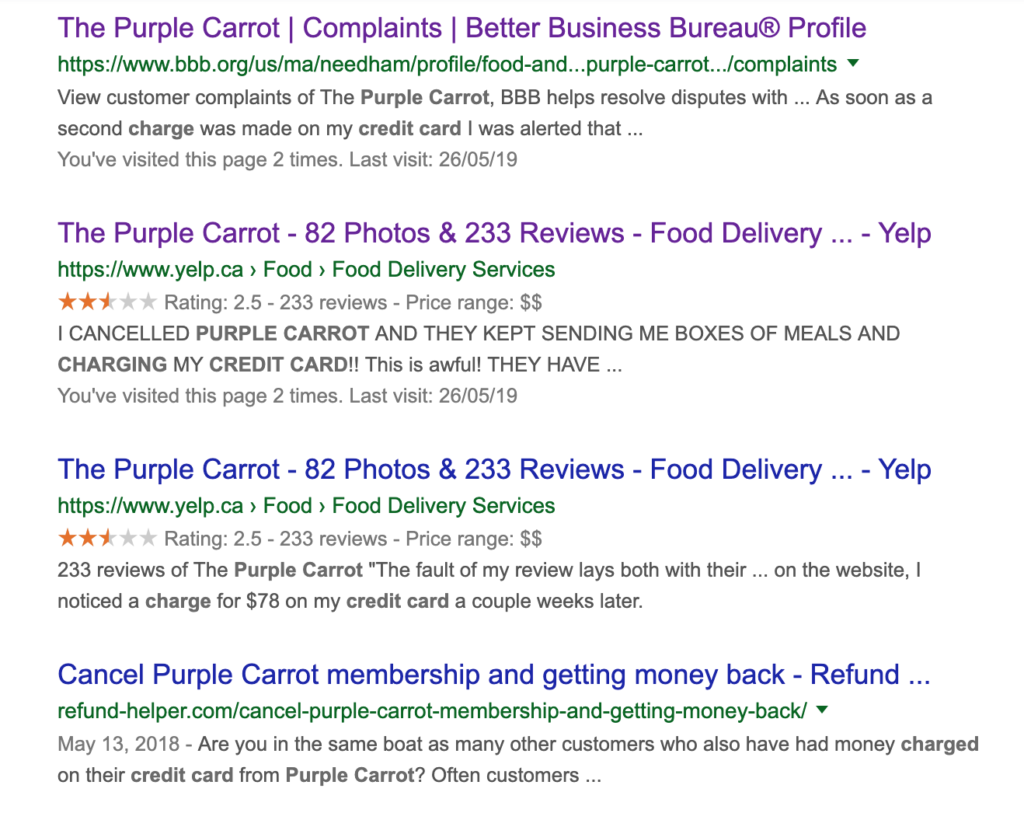
Imagine the negative impact to your business when a prospective customer searches for your brand and reads reviews like:
- “Other meal services send an advanced notification that lets you confirm or cancel an upcoming delivery. Purple Carrot doesn’t do this so I received an unexpected meal box.”
- “This is a pet peeve of mine… I don’t want companies charging my card without letting me know it’s coming.”
3) Losing customer trust: If a customer wants to temporarily take a break by skipping an order, this negative experience may cause the customer to fully cancel because of a poor customer experience. We’ll talk more about positive and negative customer actions a bit later.
By making the decision to not send upcoming order emails, it’s a conscious decision to sneak your way into a credit card statement. This is not a winning or ethical business model.
What can businesses do with these upcoming order emails?
First, understand that these type of emails have the highest open rates. This means it’s a powerful communication channel to mitigate churn and to also increase revenues by showcasing your other products to your most valuable customers.
For example, one of the most common reasons for churn is “too much volume”. These churned subscribers could still be loyal customers, they just prefer to order less frequently, or on an as-needed basis.
The below screenshot is a real example of a customer cancelling a subscription after being notified of an upcoming shipment, but remains a loyal customer.

Whereas if the business tried to sneak in a charge, it would be an extremely poor customer experience that could lose the trust of a loyal customer forever.
It’s for these reasons all the top-performing brands including Dollar Shave Club and Harry’s consider it best practice to send these pre-shipping notification emails.

Have you been curious how to use upcoming order notification emails in a more effective way? Keep reading to learn how to implement a proactive retention strategy that builds, not destroys, brand loyalty.
Measuring the impact of upcoming order emails
In order to build an effective retention strategy, you must first analyze the before and after results of turning on upcoming order emails. Use the image below to guide your churn analysis, it will help you understand the most effective way for you to combat churn.
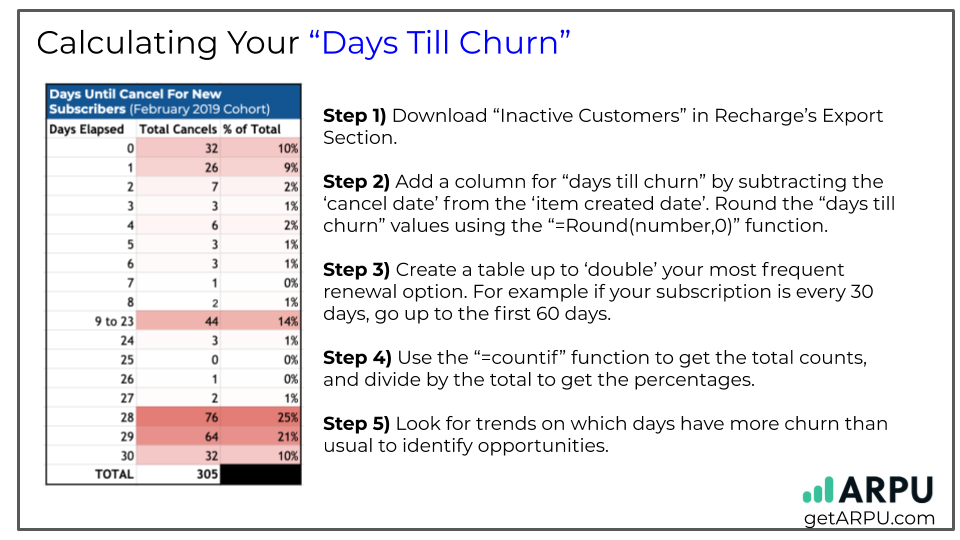
Once you have a table similar to the above screenshot and you understand the % of churn for each day leading up to the renewal, you can create a graph similar to the following:

The first few days
Subscription businesses will typically see a higher amount of churn during the first 3 days. These are typically due to bargain hunters that come with a “subscribe & save” model and will happen regardless if you have upcoming order emails enabled or disabled.
The three days prior to & after billing
Businesses that have upcoming order notification emails disabled will experience lower amounts of churn on the days leading up to the billing period. This is NOT a good thing because the only reason this is happening is because the customers aren’t aware of the upcoming charge.
The month’s recurring revenue might be higher, but in reality, the churn is being shifted from before the billing cycle, to immediately afterwards. The churn will still happen regardless because the fundamental reason why people cancel a subscription is still not addressed.
Great managers always have pairing metrics to avoid over-optimizing for a singular goal. Businesses who over-optimize for short term revenues by disabling upcoming order emails will experience an increase in product returns, refunds, and customer support tickets after the billing cycle.
Comparably, businesses that have the upcoming order notification emails enabled will see higher churn from the days prior to billing, but lower churn the days afterwards, and improved quality metrics (lower product returns/refunds/tickets).
Since upcoming order emails have one of the highest open rates compared to all other forms of emails, these emails could be used as a tool to increase retention and order value of your subscribers.
3 key features of an upcoming order email
Prior to the renewal of a subscription order, there are two types of actions an active subscriber could take:
- Positive actions
- Skipping An Order
- Modifying Order Details (address, billing information, frequency)
- Adding/Removing products (removal is still considered positive because even though your revenue may be lower due to less product being sold, the customer is still active)
- Negative actions
- Cancelling A Subscription
Note: any action that is not a cancellation is considered a positive action.
There are 3 key features of an upcoming order email to influencer subscribers to take a positive action.
Feature #1: Reducing churn by making it for subscribers to SKIP their order
“Too much volume” is one of the most common reasons for subscriber churn.
These type of customers are the easiest to retain because they’re still interested in a subscription, they just need to take a break. So it’s an opportunity to make it as easy as possible for these subscribers to skip an order.
One way to reduce this type of churn is by having a bright “delay your order” call-to-action button embedded in the upcoming order emails.
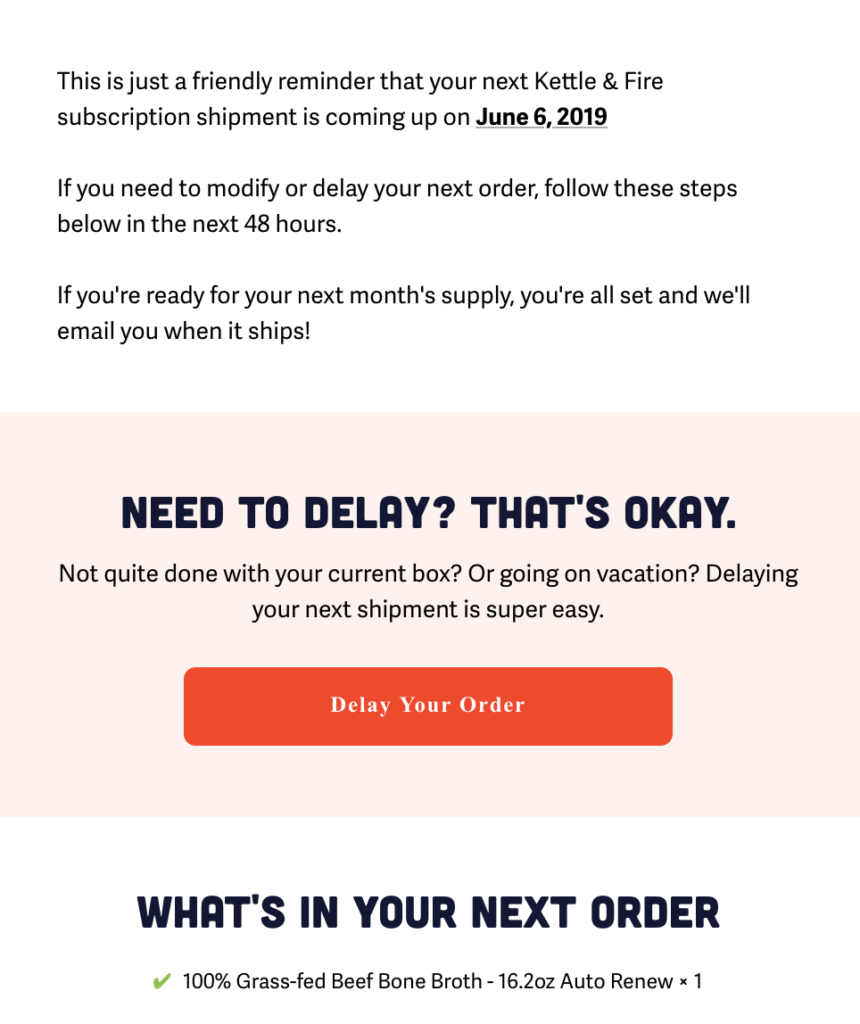
Real upcoming notification email from Kettle & Fire, sent by ARPU
The vast majority of “skipped subscribers” will make a purchase on their next cycle. If it wasn’t easy to skip an order, these subscribers could have cancelled due to frustration or not knowing that it was even possible to skip an order.
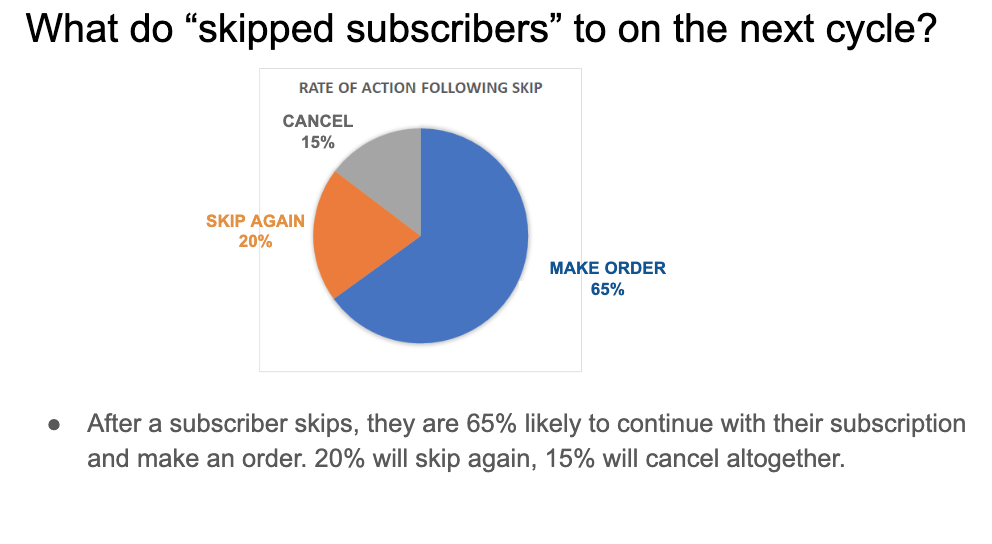
Note: You can do a similar analysis using Recharge’s Actions Report to identify all your subscribers who have “skipped an order” and the following action they performed
Feature #2: Have all replies directed and prioritized to your customer support team
Set the “reply-to” email address of your pre-shipping notification emails to your support team. Since all your emails will have the same subject line, you can set up auto-tagging in your support software to prioritize these emails.
Feature #3: Promote your other products to increase order values
In the book Marketing Metrics, the authors state, “the probability of selling to a new prospect is 5-20%. The probability of selling to an existing customer is 60-70%.”
It’s not surprising to understand why your subscribers are the most likely to try your other products. These active subscribers already trust your brand compared to buying from another business they’ve never done business with.
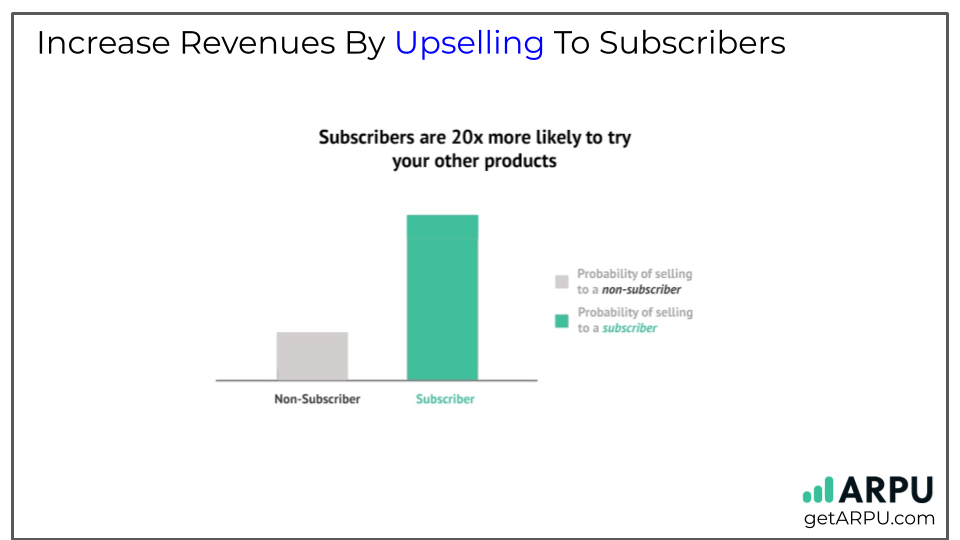
It’s a common strategy from the top-tier brands like Dollar Shave Club and Harry’s to use these recurring upcoming notification emails to upsell other products as add-ons to the next order If your subscribers enjoy the add-on product, they could then add it to their future recurring orders thus increasing lifetime value even more.

Passively increase retention and revenues
Since these emails are recurring with high open rates, it’s an important touch point with your most valuable customers to reduce churn and increase order values.
ARPU, in partnership with Recharge, ensures you provide a positive and ethical customer experience by notifying your customers before you charge their credit card. At the same time, you can leverage these emails to increase order values with a 2-click upsell (no credit card info required) and straight from the email.
Check out ARPU on the Recharge integration page. Questions? Email Wilson Hung directly at [email protected].




